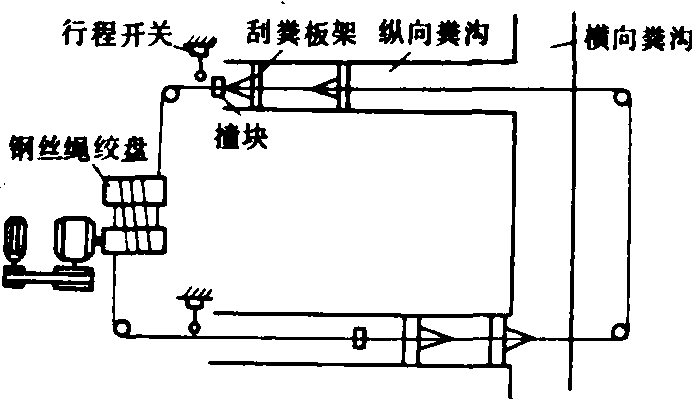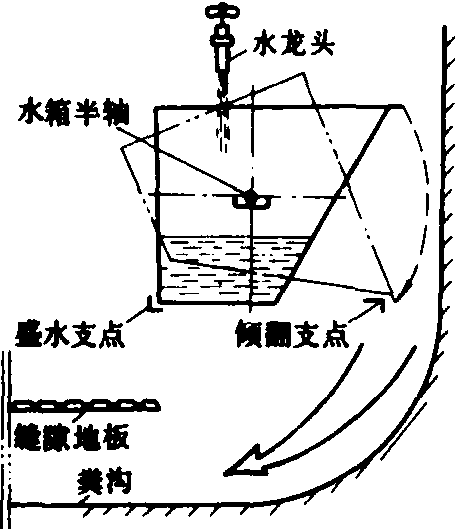猪舍清粪设备manure cleaning equipment for pig house
从猪舍内清除粪便的机械设备。猪粪肥含有丰富的有机质和氮、磷、钾,是一种水溶性、易腐熟、高肥效的优质肥料。一头猪在整个饲养期间能排泄粪尿2~2.5吨,这些粪尿如不及时清理,会严重污染环境,危及人畜健康。
清粪设备主要有机械清粪及水冲清粪两类。机械清粪有铲式清粪机和往复式刮板清粪设备。水冲清粪有闸门水冲清粪装置和翻箱式水冲清粪设备。
铲式清粪机 是在手扶拖拉机或轮式拖拉机前面安装一个悬挂铲,由拖拉机的分置液压缸或杠杆机构控制铲的起落。结构筒单、维护保养方便,工作部件不经常与粪尿接触,耐腐蚀、寿命长。常用来清除粪便通道上和运动场上的粪便,适用于前开式猪舍。
往复式刮板清粪设备 由刮粪板、传动机构及行程开关等组成(图1)。刮粪板装在猪舍两侧的粪尿沟内,工作行程时,刮板被钢丝绳向前拉成垂直状态,底边紧贴沟底,开始刮粪。返回行程时,刮粪板被钢丝绳向后拉而抬离沟底,将所刮粪便留在沟底,由于刮板的行程大于刮板的间距,待下一行程时,前一个刮板将此遗留下来的粪便再次向前推移,直至运至舍外横向排粪沟。刮板的往复运动是由装于两侧粪沟起点的两个行程开关和装在钢丝绳端点的撞块控制。往复式刮板清粪设备与水冲清粪相比,用水量少,便于实现粪尿分离,有利于后期粪尿处理,但设备长期浸于粪尿之中,易腐蚀,一般寿命只有1~2年,成本高;用于明沟清粪时,猪与粪便接触,易传染疾病,用于暗沟清粪时,粪沟需加深,沟上盖以缝隙地板。刮板在沟内运行,排除故障、检修设备极其不便,只适于规模较小的猪舍。

图1 往复式刮板清粪设备
闸门水冲清粪装置 平时在粪沟内保持一定水量,定时打开闸门用水清除粪便。水冲清粪用的粪沟由砖、水泥、钢筋水泥或陶瓷预制件构成,沟底为半圆形、直角形或梯形,粪沟上部宽70~100厘米,铺以缝隙地板。沟的始端深60~70厘米,沟底有0.005~0.01的坡降,与横向粪沟连接处设有闸门,此闸门应便于开启和关闭,关闭时应严密。
平时闸门关闭,沟内放水,深5~10厘米,猪排泄的粪便通过缝隙地板不断落入沟内,每隔3~4天打开闸门,放水冲洗,粪水混合物便由舍内粪沟冲出,经横向粪沟流入贮粪池,然后关闭闸门再次向粪沟内放水。此方式工作可靠,用水少,每头猪的日耗水量为1~1.5升,闸门还能防止冷空气进入舍内,但耗工时较多,不便于自动化。
翻箱式水冲清粪设备 如图2,它利用水箱自动倾翻造成的瞬时水流将粪沟内的粪便冲走,常与缝隙地板猪栏配合使用。盛水箱架设在畜舍一端粪沟的缝隙地板上方,其宽度与粪沟宽度相等,容量由饲养密度和粪沟长度决定,可为1吨或0.5吨。水箱两侧的半轴将水箱支承在导轨上。非工作状态时,水箱不盛水,其重心在两个半轴的左侧,靠盛水支点保持稳定。工作时,打开水箱上方的水龙头,随着水箱水面的上涨,重心逐渐右移,当水箱重心超过半轴中心时,便自动倾翻,水即冲入缝隙地板下面的粪沟,将粪便冲走。水箱倾翻到一定角度后,遇到倾翻支点,便停止转动,水箱内的水倒空后,水箱反转复位,进入下一个工作循环。

图2 翻箱式水冲除粪设备
调节水龙头的流量,可改变水箱的倾翻间隔,通常夏季每日冲洗3次、冬季每日冲洗2次。该设备自动化程度较高,但耗水量较大,平均每头每日约耗水15升。